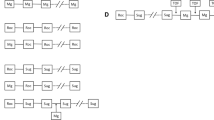Abstract
Purpose
A reduction in acetylcholine release induced by gentamicin may limit neostigmine-induced increases in acetylcholine concentration in the neuromuscular junction. An increase in acetylcholine concentration caused by neostigmine and calcium may enhance the use-dependent ion channel block of the nicotinic acetylcholine receptor caused by clindamycin. The purpose of this study was to determine whether calcium and neostigmine antagonize the neuromuscular blockade caused by gentamicin and augment the blockade caused by clindamycin during both single-twitch (0.1 Hz) and tetanic stimulation (50 Hz for 1.9 s).
Methods
Left phrenic nerve-hemidiaphragm preparations (Male Sprague-Dawley rats, 150–250 g) were mounted in Krebs solution. The concentration-response curves of gentamicin and clindamycin were obtained. The reversal effects of treatment with 5 mM calcium or 250 nM neostigmine on the effects of 1.5 mM gentamicin, which caused 72% reduction of single twitch, were studied. The effects of calcium or neostigmine on the effects of clindamycin were studied by examining the shift of the concentration-response curve of clindamycin with pretreatments with these agents. The effective concentrations were determined by a probit model.
Results
Calcium antagonized the single-twitch depression and tetanic fade caused by gentamicin more effectively than neostigmine. The effective concentration of 50% maximal effect (EC50) values of clindamycin for tetanic fade in the presence of 5 mM calcium or 250 nM neostigmine were reduced by approximately 52%.
Conclusion
Clindamycin and gentamicin interfere with neuromuscular transmission and cause tetanic fade. Neostigmine and calcium antagonized the neuromuscular blockade caused by gentamicin, but augmented that caused by clindamycin.
Similar content being viewed by others
References
Parsons TD, Obaid AL, Salzberg BM. Aminoglycoside antibiotics block voltage-dependent calcium channels in intact vertebrate nerve terminals. J Gen Physiol. 1992;99:491–504.
Torda T. The nature of gentamicin-induced neuromuscular block. Br J Anaesth. 1980;52:325–329.
Pittinger C, Adamson R. Antibiotic blockade of neuromuscular function. Ann Rev Pharmacol. 1972;12:169–184.
Lippmann M, Yang E, Au E, Lee C. Neuromuscular blocking effects of tobramycin, gentamicin, and cefazolin. Anesth Analg. 1982;61:767–770.
Caputy AJ, Kim YI, Sanders DB. The neuromuscular blocking effects of therapeutic concentrations of various antibiotics on normal rat skeletal muscle: a quantitative comparison. J Pharmacol Exp Ther. 1981;217:369–378.
Potter JM, Edeson RO, Campbell RJ, Forbes AM. Potentiation by gentamicin of non-depolarizing neuromuscular block in the cat. Anaesth Intensive Care. 1980;8:20–25.
Dotan ZA, Hana R, Simon D, Geva D, Pfeffermann RA, Ezri T. The effect of vecuronium is enhanced by a large rather than a modest dose of gentamicin as compared with no preoperative gentamicin. Anesth Analg. 2003;96:750–754.
Liu C, Hu F. Investigation on the mechanism of exacerbation of myasthenia gravis by aminoglycoside antibiotics in mouse model. J Huazhong Univ Sci Technolog Med Sci. 2005;25:294–296.
Fiekers JF. Sites and mechanisms of antibiotic-induced neuromuscular block: a pharmacological analysis using quantal content, voltage clamped end-plate currents and single channel analysis. Acta Physiol Pharmacol Ther Latinoam. 1999;49:242–250.
Prior C, Fiekers JF, Henderson F, Dempster J, Marshall IG, Parsons RL. End-plate ion channel block produced by lincosamide antibiotics and their chemical analogs. J Pharmacol Exp Ther. 1990;255:1170–1176.
Fiekers JF, Henderson F, Marshall IG, Parsons RL. Comparative effects of clindamycin and lincomycin on end-plate currents and quantal content at the neuromuscular junction. J Pharmacol Exp Ther. 1983;227:308–315.
Singh YN, Marshall IG, Harvey AL. Pre-and postjunctional blocking effects of aminoglycoside, polymyxin, tetracycline and lincosamide antibiotics. Br J Anaesth. 1982;54:1295–1306.
Best JA, Marashi AH, Pollan LD. Neuromuscular blockade after clindamycin administration: a case report. J Oral Maxillofac Surg. 1999;57:600–603.
al Ahdal O, Bevan DR. Clindamycin-induced neuromuscular blockade. Can J Anaesth. 1995;42:614–617.
Sloan PA, Rasul M. Prolongation of rapacuronium neuromuscular blockade by clindamycin and magnesium. Anesth Analg. 2002;94:123–124.
Jedeikin R, Dolgunski E, Kaplan R, Hoffman S. Prolongation of neuromuscular blocking effect of vecuronium by antibiotics. Anaesthesia. 1987;42:858–860.
Becker LD, Miller RD. Clindamycin enhances a nondepolarizing neuromuscular blockade. Anesthesiology. 1976;45:84–87.
Fogdall RP, Miller RD. Prolongation of a pancuronium-induced neuromuscular blockade by clindamycin. Anesthesiology. 1974;41:407–408.
Singh YN, Harvey AL, Marshall IG. Antibiotic-induced paralysis of the mouse phrenic nerve-hemidiaphragm preparation, and reversibility by calcium and by neostigmine. Anesthesiology. 1978;48:418–424.
Bowman WC. Prejunctional and postjunctional cholinoceptors at the neuromuscular junction. Anesth Analg. 1980;59:935–943.
Gibb AJ, Marshall IG. Pre-and post-junctional effects of tubocurarine and other nicotinic antagonists during repetitive stimulation in the rat. J Physiol. 1984;351:275–297.
Riesz M, Kapati E, Szporny L. Antagonism of non-depolarising neuromuscular blockade by aminopyridines in cats. J Pharm Pharmacol. 1986;38:156–158.
Lee C, Zhang X, Kwan WF. Electromyographic and mechanomyographic characteristics of neuromuscular block by magnesium sulphate in the pig. Br J Anaesth. 1996;76:278–283.
Chaudhry IA, Nitahara K, Nagashima H, Vizi ES. Neurochemical evidence that [Ca2+]o antagonizes the effect of neomycin on acetylcholine release from mouse hemidiaphragm preparation: an attempt to assess the margin of safety. Acta Anaesthesiol Scand. 1995;39:494–497.
Schlesinger F, Krampfl K, Haeseler G, Dengler R, Bufler J. Competitive and open channel block of recombinant nAChR channels by different antibiotics. Neuromuscul Disord. 2004;14:307–312.
Kubikowski P, Szreniawski Z. The mechanism of the neuromuscular blockade by antibiotics. Arch Int Pharmacodyn Ther. 1963;146:549–560.
Lambert JJ, Durant NN, Henderson EG. Drug-induced modification of ionic conductance at the neuromuscular junction. Ann Rev Pharmacol Toxicol. 1983;23:505–539.
Pittinger C, Adamson R. Antibiotic blockade of neuromuscular function. Annu Rev Pharmacol. 1972;12:169–184.
Author information
Authors and Affiliations
About this article
Cite this article
Lee, SI., Lee, JH., Lee, S.C. et al. Calcium and neostigmine antagonize gentamicin, but augment clindamycin-induced tetanic fade in rat phrenic nerve-hemidiaphragm preparations. J Anesth 22, 385–390 (2008). https://doi.org/10.1007/s00540-008-0646-y
Received:
Accepted:
Published:
Issue Date:
DOI: https://doi.org/10.1007/s00540-008-0646-y




